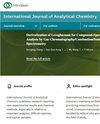利用三种紫外分光光度法同时测定口服制剂和共晶体系中新组合吲哚美辛和烟酰胺的方法开发
IF 1.5
4区 化学
Q3 CHEMISTRY, ANALYTICAL
引用次数: 0
摘要
这项研究旨在开发同时测定二元混合物、速释胶囊、缓释胶囊和共无定形系统中吲哚美辛(IND)和烟酰胺(NCT)含量的方法。此外,这种新的组合还可能具有其他医疗益处。因此,需要开发出简单、灵敏、精确的方法,用于同时定量分析几种不同比例的吲哚美辛/NCT。我们采用了三种紫外分光光度法:二阶导数中的零交叉点法、一阶导数中的双波长法以及比率减法与光谱减法相结合的方法。IND 的检出限和定量限(LOD 和 LOQ)分别为 0.41 和 1.25、0.55 和 1.66 以及 0.53 和 1.62 μg/mL,而 NCT 的检出限和定量限(LOD 和 LOQ)分别为 0.53 和 1.59、0.38 和 1.14 以及 0.36 和 1.08 μg/mL。所有方法至少在 2.5-40.0 μg/mL 范围内线性良好。所有建议的方法都根据 ICH 指南进行了验证,并在制剂中进行了应用。最后,将所提出的方法与每种 IND 和 NCT 的参照方法进行了比较,未发现明显的统计差异。本文章由计算机程序翻译,如有差异,请以英文原文为准。
Method Development for Simultaneously Determining Indomethacin and Nicotinamide in New Combination in Oral Dosage Formulations and Co-Amorphous Systems Using Three UV Spectrophotometric Techniques
This research aims to develop methods for simultaneously determining indomethacin (IND) and nicotinamide (NCT) in binary mixtures, immediate-release capsules, sustained-release capsules, and co-amorphous systems, which were designed in 2021 to improve the solubility, dissolution rate, and stability of the amorphous state of indomethacin. Moreover, this new combination may have also other possible medical benefits. Therefore, there is a need to have simple, sensitive, and precise developed methods for simultaneous quantification analysis of IND/NCT in several different ratios. Three UV-spectrophotometry techniques were deployed: zero-crossing point in the second-order derivative, dual-wavelength in the first-order derivative, and ratio subtraction coupled with spectrum subtraction. The limit of detection and the limit of quantifications (LOD and LOQ) for IND were 0.41 and 1.25, 0.55 and 1.66, and 0.53 and 1.62 μg/mL, respectively, while for NCT were 0.53 and 1.59, 0.38 and 1.14, and 0.36 and 1.08 μg/mL, respectively. All methods were linear at least in the range of 2.5–40.0 μg/mL. All proposed methods were validated according to ICH guidelines and their application on the dosage formulations was carried out. Finally, the proposed methods were compared to a reference method for each IND and NCT, and no significant statistical variance was found.
求助全文
通过发布文献求助,成功后即可免费获取论文全文。
去求助
来源期刊

International Journal of Analytical Chemistry
CHEMISTRY, ANALYTICAL-
CiteScore
3.10
自引率
5.60%
发文量
117
期刊介绍:
International Journal of Analytical Chemistry publishes original research articles that report new experimental results and methods, especially in relation to important analytes, difficult matrices, and topical samples. Investigations may be fundamental, or else related to specific applications; examples being biological, environmental and food testing, and analysis in chemical synthesis and materials processing.
As well as original research, the International Journal of Analytical Chemistry also publishes focused review articles that examine the state of the art, identify emerging trends, and suggest future directions for developing fields.
 求助内容:
求助内容: 应助结果提醒方式:
应助结果提醒方式:


